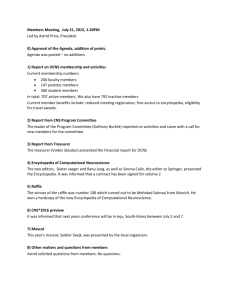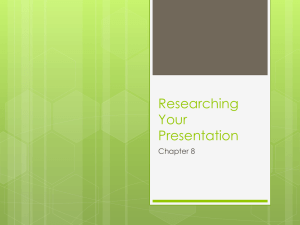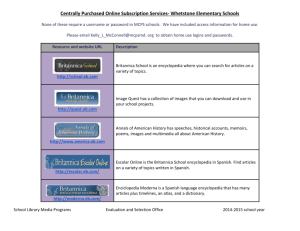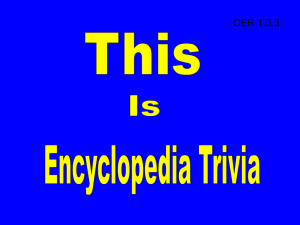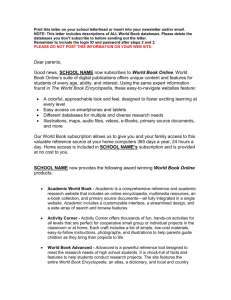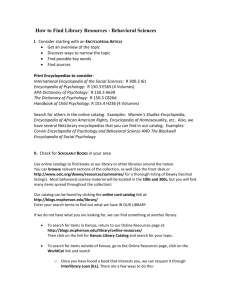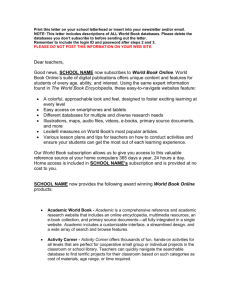HELEAD 725: Diversity and Equity in Higher Education
advertisement
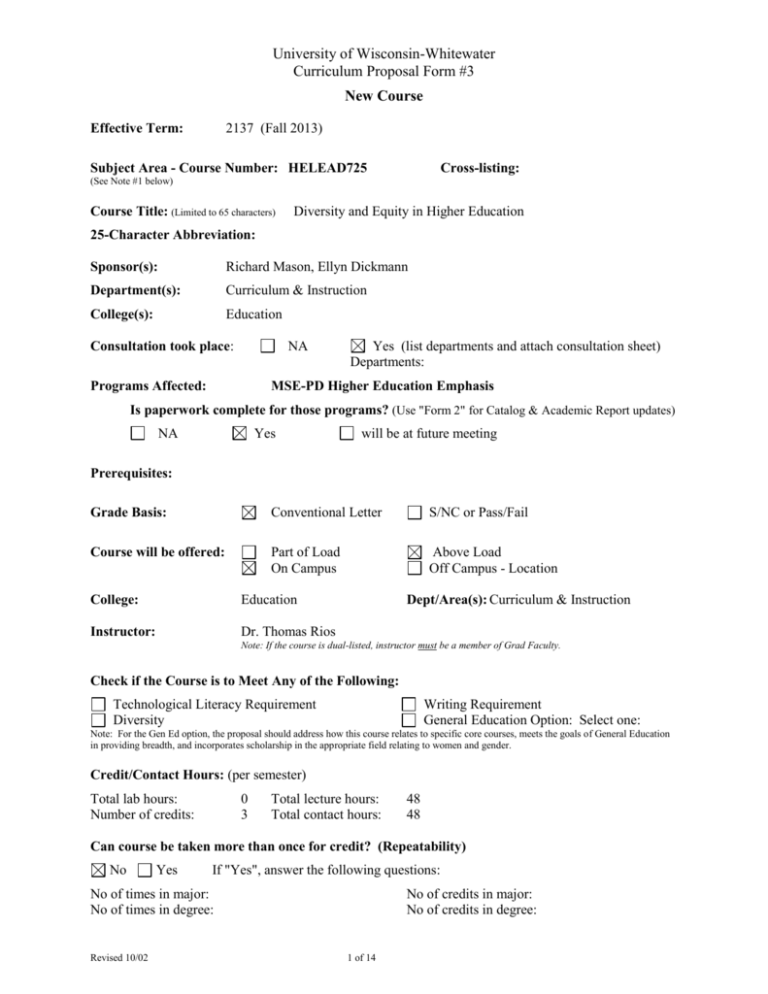
University of Wisconsin-Whitewater Curriculum Proposal Form #3 New Course Effective Term: 2137 (Fall 2013) Subject Area - Course Number: HELEAD725 Cross-listing: (See Note #1 below) Course Title: (Limited to 65 characters) Diversity and Equity in Higher Education 25-Character Abbreviation: Sponsor(s): Richard Mason, Ellyn Dickmann Department(s): Curriculum & Instruction College(s): Education Consultation took place: NA Programs Affected: Yes (list departments and attach consultation sheet) Departments: MSE-PD Higher Education Emphasis Is paperwork complete for those programs? (Use "Form 2" for Catalog & Academic Report updates) NA Yes will be at future meeting Prerequisites: Grade Basis: Conventional Letter S/NC or Pass/Fail Course will be offered: Part of Load On Campus Above Load Off Campus - Location College: Education Instructor: Dr. Thomas Rios Dept/Area(s): Curriculum & Instruction Note: If the course is dual-listed, instructor must be a member of Grad Faculty. Check if the Course is to Meet Any of the Following: Technological Literacy Requirement Diversity Writing Requirement General Education Option: Select one: Note: For the Gen Ed option, the proposal should address how this course relates to specific core courses, meets the goals of General Education in providing breadth, and incorporates scholarship in the appropriate field relating to women and gender. Credit/Contact Hours: (per semester) Total lab hours: Number of credits: 0 3 Total lecture hours: Total contact hours: 48 48 Can course be taken more than once for credit? (Repeatability) No Yes If "Yes", answer the following questions: No of times in major: No of times in degree: Revised 10/02 No of credits in major: No of credits in degree: 1 of 14 Proposal Information: (Procedures for form #3) Course justification: An increasing number of students seeking graduate-level preparation for careers in higher-education leadership in areas such as residence life, recruitment and retention, and academic support services have sought admission to the MSE-PD Educational Leadership program. This course is one of six courses being created specifically to address the needs of that group of students that will form part of a distinct emphasis in Higher Education Leadership. The population for whom these courses are intended is different from the students admitted to UW-Whitewater’s Counselor Education program – Higher Education track in that they do not have a particular interest in counseling and the positions for which they are preparing do not require them to complete a nationally-accredited program in counseling. Relationship to program assessment objectives: This course addresses CAS Standards (Parts 2, 5, & 6) for master’s-level student affairs professional preparation programs related to recruitment and admission, cultural foundations of higher education, and equity and access. This course also contributes to the achievement of MSE-PD program goals of enhancing students’ proficiency in research about higher education leadership, their understanding of professional practice in higher education, and the ability to communicate with others about, and advocate for, access and participation in higher education by students of diverse backgrounds (voice). Budgetary impact: Courses in the Higher Education Leadership emphasis will initially be taught by UW-Whitewater administrators funded by program revenue. As the program expands, the course will be taught by qualified adjunct instructors on a self-supporting basis. The population served by these courses does not overlap with the population enrolled in other master’s emphasis areas at UW-Whitewater, and availability of these courses should not affect enrollment in existing courses other than the common core courses of the MSE-PD, which should increase as more students enroll in the Higher Education Leadership emphasis. Course description: (50 word limit) This course emphasizes personal awareness, knowledge, and skills necessary for ongoing development of a personal intercultural framework for student affairs practice. Theories related to domestic and international dimensions of diversity, interactional diversity and the dynamics of power, privilege and oppression will be explored in university contexts. This course will examine challenges and opportunities for creating inclusive and affirming campus communities. If dual listed, list graduate level requirements for the following: 1. Content (e.g., What are additional presentation/project requirements?) 2. Intensity (e.g., How are the processes and standards of evaluation different for graduates and undergraduates?) 3. Self-Directed (e.g., How are research expectations differ for graduates and undergraduates?) Course objectives and tentative course syllabus: Students will be able to: 1. Develop an understanding of diversity and equity in higher education in three primary contexts: Access and Participation, Campus Climate and Curriculum, and Outcomes. Students will use this understanding to participate in class discussions, group projects and written assignments. Revised 10/02 2 of 14 2. Understand information, concepts, policies, and controversies related to gender, race, ethnicity, sexual orientation, socio-economic status, ability, and religious differences among students, faculty, administrators, and other employees in postsecondary settings. Students will demonstrate this understanding through specific written assignments. 3. Describe and analyze historical and contemporary issues related to diversity and equity, and discuss current trends and coming challenges in educational research, theory, policy, and practice. The descriptions, analyses, and discussions will be synthesized into a reflective paper. Bibliography: (Key or essential references only. Normally the bibliography should be no more than one or two pages in length.) The following books/articles were critical to the development of this course: Borrego, S.E. (2008). Class matters: Beyond access to inclusion. Washington, DC: National Association of Student Personnel Administrators. Chhuon, V., & Hudley, C. (2008). Factors supporting Cambodian American students' successful adjustment into the university. Journal of College Student Development, 49, 15-30. Cuyjet, M.J., Howard-Hamilton, M.F., Cooper, D. L. (2011). Multiculturalism on campus: Theory, models, and practices for understanding. Sterling, VA: Stylus Publishing. Dugan, J. P., & Yurman, L. (2011). Commonalities and differences among lesbian, gay, bisexual and transgender college students: Considerations for research and practice. Journal of College Student Development, 52, 201-216. Edwards, K., & Jones, S. (2009). “Putting my man face on”: A grounded theory of college men’s gender identity development. Journal of College Student Development, 50, 210-228. Parks, S. (2000). Big questions worthy dreams. San Francisco: Jossey-Bass Publishers. Horn, L., Berktold, J., Bobbitt, L. (June, 2010). Executive summary, introduction, profile of undergraduates with disabilities, and access to postsecondary education (pp. iii-vii and 136) from Students with disabilities in postsecondary education: A profile of preparation, participation, and outcomes. National Center for Education Statistics Statistical Analysis Report. Washington, DC: U.S. Department of Education Office of Educational Research and Improvement. Johnson, D., Soldner, M., Leonard, J., Alvarez, P., Inkelas, K., Rowan-Kenyon, H., & Longerbeam, S. (2007). Examining sense of belonging among first-year undergraduates from different racial/ethnic groups. Journal of College Student Development, 48, 525- 542. Martínez Alemán, A.M., & Renn, K.A. (2002). Women in higher education: An encyclopedia. Santa Barbara, CA: ABC-CLIO. Melendez, M. C., & Melendez, N. B. (2010). The influence of parental attachment on the college adjustment of white, black, and Latina/Hispanic women: A cross-cultural investigation. Journal of College Student Development, 51, 419-435. Revised 10/02 3 of 14 Miville, M., Darlington, P., Whitlock, B., & Mulligan, T. (2005). Integrating identities: The relationships of racial, gender, and ego identities among white college students. Journal of College Student Development, 46, 157-175. Moran R. F. (2009). The Heirs of Brown: The Story of Grutter vs. Bollinger. In R.F. Moran & C.E. Carbado (Eds.), Race Law (pp. 451-62). Irvine: CA. University of California Irvine Press Mueller, J. A., & Cole, J. C. (2009). A qualitative examination of heterosexual consciousness among college students. Journal of College Student Development, 50, 320-336. Nadal, K. L., Pituc, S. T., Johnston, M. P., & Esparrago, T. (2010). Overcoming the model minority myth: Experiences of Filipino American graduate students. Journal of College Student Development, 51, 694-706. Okagaki, L., Helling, M., & Bingham, G. (2009). American Indian college students’ ethnic identity and beliefs about education. Journal of College Student Development, 50, 157176. Ratanasiripong, P., & Rodriguez, A. (2011). Promoting wellness for Thai college students. Journal of College Student Development, 52, 217-223. Sanchez, D., & Carter, R. (2005). Exploring the relationship between racial identity and religious orientation among African American college students. Journal of College Student Development, 46, 280-295. Schwartz, J., Donovan, J., & Guido-DiBrito, F. (2009). Stories of social class: Self- identified Mexican male college students crack the silence. .Journal of College Student Development, 50, 50-66. Smith, W.A., Altbach, P.G., & Lomotey, K. (Eds.). (2009). The racial crisis in American higher education: Continuing challenges for the Twenty-first century. Second edition. Albany: State University of New York Press. Turner, C.S., Antonio, A.L., García, M., Laden, B.V., Nora, A., & Presley, C.L. (2002). Racial and ethnic diversity in higher education. ASHE Reader Series. Boston, MA: Pearson Custom Publishing. Course Objectives and tentative course syllabus with mandatory information (paste syllabus below): Revised 10/02 4 of 14 HELEAD725 Diversity and Equity in Higher Education (Proposed Course for UW-Whitewater’s Master of Science in Education in Professional Development — emphasis on Higher Education Leadership) Your success in this class is important to us. If there are circumstances that may affect your performance in this class, please let us know as soon as possible so that we may work together to develop strategies for adapting assignments to meet both your needs and the requirements of the course. The Center for Students with Disabilities (262) 472-4711 provides resources for students with disabilities. You will need to provide them with documentation of disability in order to receive official university services and accommodations. COURSE DESCRIPTION This course emphasizes personal awareness, knowledge, and skills necessary for ongoing development of a personal intercultural framework for student affairs practice. Theories related to domestic and international dimensions of diversity, interactional diversity and the dynamics of power, privilege and oppression will be explored in university contexts. This course will examine challenges and opportunities for creating inclusive and affirming campus communities. CONCEPTUAL FRAMEWORK Our conceptual framework, The Teacher is a Reflective Facilitator, is the underlying structure in our teacher preparation program at UW-Whitewater. This structure gives conceptual meanings through an articulated rationale to our operation. It also provides direction for our licensure programs, courses, teaching, candidate performances, faculty scholarship and service, and unit accountability. In short, our teacher education program is committed to reflection upon practice; to facilitation of creative learning experiences for pupils’ to constructivism in that all learners must take an active role in their own learning; to information and technology literacy; to diversity; and to inquiry (research scholarship) and assessment. Therefore, all syllabi pertaining to courses required for licensure reflect commitment to these underlying principles COURSE KNOWLEDGE AND LEARNING OBJECTIVES Revised 10/02 5 of 14 4. Students will develop an understanding of intercultural diversity and equity in higher education in three primary contexts: Access and Participation, Campus Climate and Curriculum, and Outcomes. 5. Within these three areas, the course is designed to introduce students to information, concepts, policies, and controversies related to gender, racial, ethnic, sexual orientation, socio-economic, ability, and religious differences among students, faculty, administrators, and other employees in postsecondary settings. 6. The successful student in this course will be able to describe and analyze historical and contemporary issues related to diversity and equity, as well as discuss current trends and coming challenges in educational research, theory, policy, and practice. REQUIRED TEXTS Smith, W.A., Altbach, P.G., & Lomotey, K. (Eds.). (2002). The racial crisis in American higher education: Continuing challenges for the Twenty-first century. Albany: State University of New York Press. Martínez Alemán, A.M., & Renn, K.A. (2002). Women in higher education: An encyclopedia. Santa Barbara, CA: ABC-CLIO. Turner, C.S., Antonio, A.L., García, M., Laden, B.V., Nora, A., & Presley, C.L. (2002). Racial and ethnic diversity in higher education. ASHE Reader Series. Boston: Pearson Custom Publishing. Additional readings will be available via D2L EXPECTATIONS FOR STUDENTS We have three expectations for students in this course: 1. Seek First to Understand, Then to be Understood. Stephen Covey in his book, The 7 Habits of Highly Effective People (1989), claims that this habit distinguishes effective people from their less effective counterparts. In higher education, we tend to put a great emphasis on critical thinking. The problem that often arises among students (and practitioners) is that they tend to first criticize an author, idea, colleague, or classmate without first seeking to understand his or her perspective. Don’t do this. 2. THNIK for yourself. (No, there isn’t a typo here.) Graduate education isn’t about memorizing facts or repeating your professor’s thoughts; it’s about taking information and transforming it into “knowledge” — by making meaning of it. We expect you to be co-learners with us — to advance OUR learning, and to be able to describe how the course prompts your curiosities for further independent learning. Be different: THNIK. 3. Attendance and Engagement. Students who are absent three or more sessions will not receive credit for the course. Absences up to 3 will be accounted for and potentially affect final grades. A considerable part of learning about and understanding the issues involved in higher education is through reading, discussing, and reflecting. Engagement with the materials is necessary for the success of the course. We expect you to be prepared for class and participate actively, thoughtfully, and with respectful consideration for other students. We will call upon you in class to express your thoughts and to enhance the engagement of all. ASSIGNEMENTS: • Research paper (40%) Up to 17 page research paper on a topic you select and instructor agrees to. The paper is due in stages as outlined below. Revised 10/02 6 of 14 • A workable topic with a brief description (not to exceed one page) is due on week three. Topics must be related to issues of diversity and/or equity in postsecondary education. They may focus on any postsecondary sector(s) (e.g., community colleges, four-year institutions, research institutions; public, private, non-sectarian, for profit, religiously-affiliated, etc.) and/or on any population within higher education (e.g., students, faculty, administrators, other employees; groups by gender, race, ethnicity, age, sexual orientation, ability, etc.). They may address access, participation, policy, campus climate, curriculum, teaching and learning, history, or another area of importance in higher education. • A list of probable sources is due on Week 5. Sources may include journal articles, books, book chapters, websites (be careful of credibility). You should have at least 15 sources in this preliminary list; you can add additional sources for the final document, and you may decide not to include some from this preliminary list. Please indicate your topic at the top of your list of probable sources. • Complete paper is due on final week of class. Papers should be up to 17pages of text (excluding cover page and reference list). • Take home mid-term and final examinations (20% each) Each exam is a take home, open book exam, consisting of a number of questions. For each question you choose to answer, you will write an essay of 5-6 pages length. Questions will call on you to integrate and synthesize material from the course, citing appropriate sources to support your arguments. • Presentation of your research paper (10%) Plan and present a 10 minute summary of the most important points of your paper or lit review. You can use any presentation media you choose. GRADING BREAKDOWN AND STANDARDS: Assignments/Exams Personal Theory Paper (20%) Formal Theory Paper (30%) Voice Journal (25%) Final Exam (25%) Grading scale: 94-100 = A 87-93 = A/B 80 – 86 = B 73-79 = B/C 72 or < = C About grading: An “A” paper is excellent—very strong in every sense. It represents a very solid job in addressing all aspects of the assignment, shows complex thinking and insight, reflects graduate-level writing (including introductory and concluding comments and appropriate transitions linking various sections), and is mostly free of errors (e.g., APA, grammar, spelling, syntax, logic, organization, clarity, style). A “B” paper is good. It has some weaknesses in one of more of these areas but captures the essential elements of the assignment. Lower grades are assigned to papers with more significant weaknesses in the areas noted above and do not reflect the quality expected in graduate-level studies. Course Schedule Revised 10/02 7 of 14 Week One Introduction and Course Overview What do we mean by “diversity” in higher education? What do we mean by “equity” in higher education? ACCESS and PARTICIPATION Week Two Historical Overview of Access and Participation Readings for today: - Anderson, G. (2002). Access. In J.J.F. Forest & K. Kinser (Eds.), Higher education in the United States: An encyclopedia (pp. 19-26). Santa Barbara, CA: ABC-CLIO. - Coaxum, J. (2002). Equity. In J.J.F. Forest & K. Kinser (Eds.), Higher education in the United States: An encyclopedia (pp. 196-200). Santa Barbara, CA: ABC-CLIO. - Nidiffer, J. Overview to Historical and Cultural Contexts. Encyclopedia. - Anderson, J.D. Race in American higher education: Historical perspectives on current conditions. Racial Crisis. - Ogren, C.A. (1999, November 19). Rethinking the “nontraditional” student from a historical perspective. Paper presented at the Association for the Study of Higher Education Annual Meeting, San Antonio, TX. - Moreno, J.F. The elusive quest for equality: 150 years of Chicano/Chicana education. ASHE Reader. - Nakanishi, D.T. Asian Pacific Americans and colleges and universities. ASHE Reader. - Thompson, C.J. Historical origins of change: Implications for African Americans in higher education. ASHE Reader. Week Two Continue Historical Overview Readings for today: - Somers, P. Title IX. Encyclopedia. - Micheletti, L.M. Coeducation. Encyclopedia. - VanDerLinden, K. History of women in community colleges. Encyclopedia. - Turk, D.B. Jewish students. Encyclopedia. - Béjar, E.M. Hispanic-serving institutions. Encyclopedia. - Béjar, E.M. Historically Black colleges and universities. Encyclopedia. - Rousey, A. Tribal colleges and universities. Encyclopedia. - Jacobs, S. Military colleges. Encyclopedia. - Wolf-Wendel, L.E. Women’s colleges. Encyclopedia. - Teddlie, C., & Freeman, J.A. Twentieth-century desegregation in U.S. higher education: A review of five distinct historical eras. Racial Crisis. - Madaus, J.W. (2002). Services for college and university students with disabilities: A historical perspective. Journal of Postsecondary Education and Disability, 14 (1), 4-21. [ANGEL] Revised 10/02 8 of 14 - Dilley, P. (2002). 20th century postsecondary practices and policies to control gay students. Review of Higher Education, 25, 409-432. [locate online] - Benham, M.K.P. (2003). The journey of the Native American Higher Education Initiative and tribal colleges and universities. In M.K.P. Benham & W.J. Stein (Eds.), The renaissance of American Indian higher education: Capturing the dream (pp. 3-24). Mahwah, NJ: Lawrence Erlbaum Associates, Publishers. Week Three Current Status of Access and Participation Readings for today: - Solmon, L.C., Solmon, M.S., & Schiff, T.W. The changing demographics: Problems and opportunities. Racial Crisis. - Sacks, P. (2003, July 25). Class rules: The fiction of egalitarian higher education. The Chronicle of Higher Education, B7-10. [locate and print] - Olivas, M.A. Indian, Chicano, and Puerto Rican colleges: Status and issues. ASHE Reader. - Bernal, E.M., Jalomo, R.E., & Nora, A. The relationship between race and socioeconomic status (SES): Implications for institutional research and admissions policies. ASHE Reader. - Ortiz, A.M., & HeavyRunner, I. (2003). Student access, retention, and success: Models of inclusion and support. In M.K.P. Benham & W.J. Stein (Eds.), The renaissance of American Indian higher education: Capturing the dream (pp. 215-240). Mahwah, NJ: Lawrence Erlbaum Associates, Publishers. [ANGEL] - Horn, L., Berktold, J., Bobbitt, L. (June, 2010). Executive Summary, Introduction, Profile of Undergraduates with Disabilities, and Access to Postsecondary Education (pp. iii-vii and 1-36) from Students with disabilities in postsecondary education: A profile of preparation, participation, and outcomes. National Center for Education Statistics Statistical Analysis Report. Washington, DC: U.S. Department of Education Office of Educational Research and Improvement. [locate at: http://nces.ed.gov/pubsearch/pubsinfo.asp?pubid=1999187] Research Paper Topics Due Week Three Affirmative Action in Employment and Admissions Readings for today: - Alger, J. (2003). Summary of Supreme Court decisions in admissions cases. Ann Arbor: University of Michigan. Retrieve from http://www.umich.edu/~urel/admissions/overview/ - Schmidt, P. (2003, July 4). Affirmative Action survives, and so does the debate. Chronicle of Higher Education, S1-S4. OPTIONAL: - Text of Supreme Court’s opinions in Grutter v. Bollinger (the LawSchool case). Available at http://chronicle.com/free/documents/v49/i43/grutter.pdf - Text of Supreme Court’s opinions in Gratz v. Bollinger (the Revised 10/02 9 of 14 undergraduate case). Available at http://chronicle.com/free/documents/v49/i43/gratz.pdf CAMPUS CLIMATE Week Four Defining and Assessing Campus Climate Readings for today: - Cress, C.M. Campus climate. Encyclopedia. - Hurtado, S., Milem, J.F., Clayton-Pedersen, A.R., & Allen, W.R. Enhancing campus climates for racial/ethnic diversity: Educational policy and practice. ASHE Reader. - Feagin, J.R., Vera, H., & Imani, N. Educational choices and a university’s reputation: The importance of collective memory. Racial Crisis. - Allan, E.J. (2003). Constructing women’s status: Policy discourse of women’s commission reports. Harvard Educational Review, 73 (2). Week Five Climate Issues for Specific Groups (Race & Ethnicity) Readings for today: - Hurtado, S. Creating a climate of inclusion: Understanding Latina/o college students. Racial Crisis. - Chang, M.J., & Kiang, P.N. New challenges of representing Asian American students in U.S. higher education. Racial Crisis or ASHE Reader. - Brown, M.C., II. Ebony men in the ivory tower: A policy perspective. ASHE Reader. - Allen, W.R., Epps, E.G., Guillory, E.A., Suh, S.A., Bonous-Hammarth, M., & Stassen, M.L.A. Outsiders within: Race, gender, and faculty status. Racial Crisis. - Turner, C.S.V., & Myers, S.L., Jr. Snapshots from the literature: Elements influencing the workplace environment. ASHE Reader. Choose one or more of these: - King, K. African American women faculty. Encyclopedia. - Johnson, B. American Indian women faculty. Encyclopedia. - Calasanti, T., & Smith, J.W. Latina faculty. Encyclopedia. - Bassett, R.M. Asian American women faculty. Encyclopedia. Choose one of more of these: - Woods, R.L. African American students. Encyclopedia. - Geertz González, R. American Indian students. Encyclopedia. - Bassett, R.M. Asian American students. Encyclopedia. - Ortiz, S.J. Biracial and biethnic students. Encyclopedia. - Yosso, T.J. Latina students. Encyclopedia. And choose one of these: - Villalpando, O., & Delgado Bernal, D. A critical race theory analysis of barriers that impede the success of faculty of color. Racial Crisis. - Scheurich, J.J., & Young, M.D. White racism among White faculty: Revised 10/02 10 of 14 From critical understanding to antiracist activism. Racial Crisis. List of Probable Sources for Research Paper Due Mid Term Take Home Exam Distributed Week 6 Climate Issues for Specific Groups (Gender) Readings for today: - Cooper, J. Overview of Women Faculty. Encyclopedia. - Adair, V. Overview of Women and Higher Education Policy. Encyclopedia. - Glazer-Raymo, J. Gender inequality. Encyclopedia. - Allan, E.J. Classroom climate. Encyclopedia. - Bonnette, C.M. (2000). Title IX basics. Indianapolis, IN: Good Sports, Inc., Title IX and Gender Equity Specialists. Retrieve from: Mid Term Take Home Exam Due Week Seven Climate Issues, continued (Sexuality) Readings for today: - Talburt, S. Lesbian faculty. Encyclopedia. - Tillery, S.M. Sexuality. Encyclopedia. - Dolan, J. (1998). Out on campus. Academe, 84 (5), 40-46. Retrieve through ProQuest. - Brauer, D. V. (2003). Dismantling the velvet-lined closet: The generational schism within LGBTQA campus communities. The Vermont Connection, 24, 99-110. Week Eight Week Nine Revised 10/02 Climate Issues, continued (Faith Traditions) - McMurtrie, B. (2001, November 9). For many Muslim students, college is a balancing act: Campus life consists of frequent conflicts and occasional compromises with secular culture. Chronicle of Higher Education, A55. - Lee, J.J. (2002). Changing worlds, changing selves: The experience of the religious self among Catholic collegians. Journal of College Student Development, 43, 341-356. [locate and print] - Constantine, M.G., Wilton, L., Gainor, K.A., & Lewis, E.L. (2002). Religious participation, spirituality, and coping among African American college students. Journal of College Student Development, 43, 605-613. [locate and print] - Kolko, V. B. (2003). A history of Jews in American higher education. Indiana University Student Personnel Association Journal. Retrieved January 9, 2003 from http://www.indiana.edu/~iuspa/Journal/2003/History%20of %20Jews.pdf Climate Issues, continued (Ability, Social Class) Readings for today: - Walpole, M. Socioeconomic status. Encyclopedia. - hooks, b. (2000, November 17). Learning in the shadow of race and 11 of 14 class. Chronicle of Higher Education, B14-16. - LaPaglia, N. (1995). Working-class women as academics: Seeing in two directions, awkwardly. In C.L. Barney Dews & C.L. Law (Eds.), This fine place so far from home: Voices of academics from the working class (pp. 177-186). Philadelphia: Temple University Press. [ANGEL] - Rendón, L. From the Barrio to the academy: Revelations of a Mexican American scholarship girl. ASHE Reader. - Borrego, S.E. (2003). Class matters: Beyond access to inclusion. Washington, DC: National Association of Student Personnel Administrators. [ANGEL] -Pliner, S.M. Women with disabilities. Encyclopedia. - Fisher, M. (July 18, 2002). Light at the end of the tunnel. Black Issues in Higher Education, 19 (11), 24-26. CURRICULUM Week Ten Approaches to – and Controversies Regarding – Diversity and Multiculturalism in Curriculum Readings for today: - Curriculum overview - Encyclopedia - Banks, J.A. Multicultural education: Historical development, dimensions, and practice. ASHE Reader. - García, M., & Smith, D.G. Reflecting inclusiveness in the curriculum. ASHE Reader. - Coughlin, E.K. (1992). Scholars confront fundamental question: Which vision of America should prevail? Chronicle of Higher Education. - Purcell, F. Women’s studies. Encyclopedia. - Jones, B.A. (2002). African American studies. In J.J.F. Forest & K. Kinser (Eds.), Higher education in the United States: An encyclopedia (pp. 53-55). Santa Barbara, CA: ABC-CLIO. - Wang, L.L. (2002). Asian American studies. In J.J.F. Forest & K. Kinser (Eds.), Higher education in the United States: An encyclopedia (pp. 75-80). Santa Barbara, CA: ABC-CLIO. [ - Delgado Bernal, D., & Gándara, P. (2002). Latina/o, Hispanic, Chicana/o studies. In J.J.F. Forest & K. Kinser (Eds.), Higher education in the United States: An encyclopedia (pp. 383-385). Santa Barbara, CA: ABC-CLIO. - Dilley, P. (2002). Lesbian and gay studies. In J.J.F. Forest & K. Kinser (Eds.), Higher education in the United States: An encyclopedia (pp. 395-397). Santa Barbara, CA: ABC-CLIO. - Stein, W.J. (2002). Native American studies. In J.J.F. Forest & K. Kinser (Eds.), Higher education in the United States: An encyclopedia (pp. 430-432). Santa Barbara, CA: ABC-CLIO. Week Eleven Curriculum: Approaches and Controversies continued Readings for today: - Morrison, T. How can values be taught in the university? ASHE Reader. - Gitlin, T. The rise of “identity politics”: An examination and a Revised 10/02 12 of 14 critique. ASHE Reader. - Chan, S. On the ethnic studies requirement: Part 1: Pedagogical implications. ASHE Reader. -Martínez Alemán, A.M. (2001). Community, higher education, and the challenged of multiculturalism. Teachers College Record, 103, 485-503. -Willie, C.V. (1992). Multiculturalism bashing: A review of magazine coverage. Change, 24 (1), 70-73. -Thelin, J.R. (1992). The curriculum crusades and the conservative backlash. Change, 24 (1), 17-23. -Levine, A., & Cureton, J. (1992). The quiet revolution: Eleven facts about multiculturalism and the curriculum. Change, 24 (1), 25-29. (cont…) OUTCOMES Week Twelve Student Outcomes Readings for today: - Steele, C.M. A threat in the air: How stereotypes shape intellectual identity and performance. ASHE Reader. - antonio, a.l. Diversity and the influence of friendship groups in college. ASHE Reader. - Astin, A.W. Diversity and multiculturalism on campus: How are students affected? ASHE Reader. -Terenzini, P.T., Cabrera, A.F., Colbeck, C.L., Bjorklund, S.A., & Parente, J.M. Racial and ethnic diversity in the classroom: Does it promote student learning? ASHE Reader. - Rendón, L.I., Jalomo, R.E., & Nora, A. Theoretical considerations in the study of minority student retention in higher education. ASHE Reader. - Horn, L., Berktold, J., Bobbitt, L. (June, 2010). Students with disabilities in postsecondary education: A profile of preparation, participation, and outcomes. National Center for Education Statistics Statistical Analysis Report. Washington, DC: U.S. Department of Education Office of Educational Research and Improvement. [locate at: http://nces.ed.gov/surveys/peqis/publications/2000092/ ] Week 13 Faculty and Administrator Outcomes Readings for today: - Perna, L. Tenure and promotion. Encyclopedia. - Tierney, W.G., & Bensimon, E.M. Socialization and cultural taxation: Race and ethnicity in the academy. ASHE Reader. - Lindsay, B. Forging new university initiatives in the twenty-first century: Women executives and equity. ASHE Reader. Week 14 Revised 10/02 Research Paper Presentations Research Paper Due 13 of 14 Final Exam Take Home—Distributed Week 15 Research Paper Presentations/Course Wrap Up Final Exam Take Home Due The University of Wisconsin-Whitewater is dedicated to a safe, supportive and non-discriminatory learning environment. It is the responsibility of all undergraduate and graduate students to familiarize themselves with University policies regarding Special Accommodations, Academic Misconduct, Religious Beliefs Accommodation, Discrimination and Absence for University Sponsored Events (for details please refer to the Schedule of Classes; the “Rights and Responsibilities” section of the Undergraduate Catalog; the Academic Requirements and Policies and the Facilities and Services sections of the Graduate Catalog; and the “Student Academic Disciplinary Procedures (UWS Chapter 14); and the “Student Nonacademic Disciplinary Procedures" (UWS Chapter 17). Revised 10/02 14 of 14
